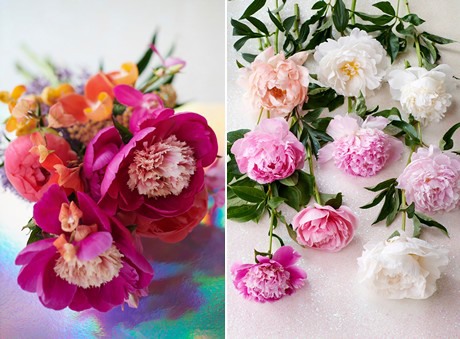No flower so fittingly illustrates the blooming strength of May as the peony. The buds are balls of compressed energy that - when the time comes - open very quickly and smell beautiful. The single-flowered peonies then display a fabulous heart, whilst the double-flowered varieties produce a cheerful full mop-head of soft petals. They can have a diameter of 15-18cm, and are particularly offered in white, various shades of pink and claret. They flower in May and June, and offer a romantic taste of the summer to come.

Credit: Funnyhowflowersdothat.co.uk
Origin
The peony originates from China and arrived in Europe around 1785. They are in their own family (Paeonia) with just one genus: the peony.
Range
The range of peonies is large, and there are hundreds of cultivars. Alongside white, pink and claret they also come in lilac, salmon pink (this is particularly popular as a match for Living Coral, the Pantone Colour for 2019), pale yellow and red. The flower shape can vary between double-flowered, single-flowered and anemone-flowered. Many peonies have a very strong sweet scent which makes the flowers even more appealing. The transformation from a bud which is some 3cm across into a flower with a diameter of over 15cm is always spectacular.
Care tips for professionals
Using very clean vases or buckets, store the peonies in cool conditions and on a layer of water with bulb flower food. Ensure that the flowers cannot get damp due to excessive humidity or from condensation caused by temperature fluctuations. This will encourage botrytis, a fungus which rapidly diminishes the decorative value. With peonies this is often called blight, and can be seen by small brown spots on the flowers or the leaves.
Inspiration & information
Inspiring images of every flower on the Flower Agenda have been produced in line with the Horticulture Sector Trends 2019 (Groenbranche Trends 2019). These trends are a translation of the latest consumer trends and are specifically aimed at the horticulture sector for use both indoors and outdoors. For more information about the Flower Agenda read more.
For more information:
Funnyhowflowersdothat.co.uk
